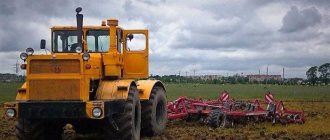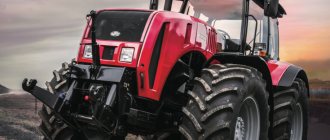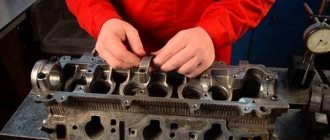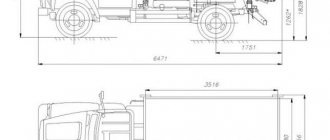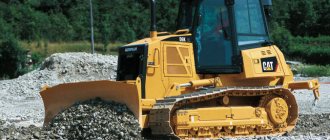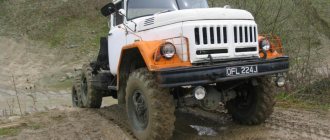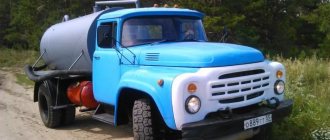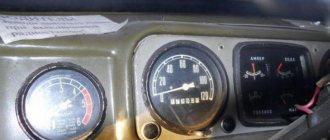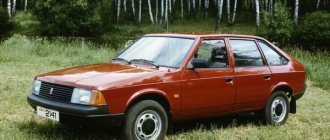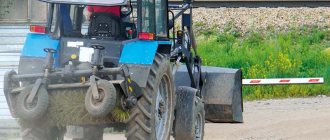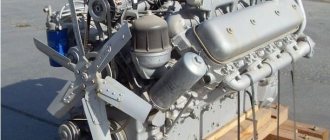The agricultural unit produced by the Minsk Tractor Plant, MTZ 82, is better known as “Belarus”. This universal type of wheeled special equipment has established itself as a highly productive, reliable and easy-to-use special equipment. The MTZ-82 tractor, whose technical characteristics are often many times superior to similar European brands, is widely used not only in the CIS countries, but also in Europe.
MTZ 82 is a model of MTZ 52 modernized in 1974. More than 40 years have passed, but Belarus-82 is still in great demand in many countries. MTZ 82 was the first Soviet tractor to be tested at the US International Center (Nebraska). The stable demand for this equipment is explained by the low cost, availability of spare parts, high endurance and productivity.
Technical parameters, operational characteristics
The versatility and versatility in use of the tractor are ensured by the following technical characteristics (parameters and descriptions for the manufactured modification are given):
- Traction class – 1.4
- Drive – four-wheel drive (4x4).
- Load capacity – 3.2 tons.
- Engine:
- model – D-243.
- type - four-cylinder diesel, with direct fuel injection, without turbocharging and liquid cooling:
- power – 81.0 l. With.,
- engine volume – 4.75 l,
- fuel consumption rate – 230 g/(kW h),
- weight – 0.43 t.
- Dimensions:
- wheelbase – 2.45 m,
- width – 1.98 m,
- length – 4.12 m,
- height – 2.80 m,
- agricultural clearance – 0.65 m,
- turning radius – 4.50 m.
- Transmission:
- Gearbox – manual, stepped,
- number of forward gears – 18,
- number of reverse gears – 4,
- clutch - with one disc, dry version,
- rear axle differential lock – hydraulic,
- highest (lowest) speed:
- forward speed – 34.40 (1.90) km/h,
- reverse - 9.22 (4.09) km/h.
- Hydraulic system:
- type – universal, aggregate-separate,
- productivity – 45 l/min,
- highest pressure – 20 MPa,
- volume – 25 l.
- Standard tire size:
- on the front axle – 11.20-20.
- on the rear axle - 15.5R38.
- Common data:
- weight – 3.5 t,
- tank volume – 130 l,
- wheel track (min., max.);
- front – 1.43 – 1.99 m,
- rear – 1.40 – 2.10 m.
The technical characteristics and operational parameters inherent in the design allow high-quality agricultural work and other mechanized operations.
This is interesting: Tractor MTZ 132N Belarus: technical characteristics, engine, fuel consumption
Performed operations, equipment for Belarus 82
The review of the MTZ 82 tractor presented in the factory catalog determines that it is most widespread when:
- soil preparation (plowing, harrowing, cultivation);
- fertilization;
- processing of agricultural plants, harvesting;
- transportation of goods;
- loading and unloading operations.
In this case, a large amount of the following specialized equipment is used together:
- trailed and mounted plows for various types of plowing;
- harrows, levelers, cultivators;
- combined units for tillage;
- rippers, shredders;
- mowers;
- pitchfork;
- devices for stacking;
- mowers;
- silage cutters;
- trailers, semi-trailers, platforms;
- loaders.
In farming and agricultural settings, loading and unloading operations are often required.
Purchasing specialized equipment for this work is expensive, since it is not possible to load the equipment for the whole year.
Therefore, the ability to aggregate MTZ 82 with loading and unloading equipment is considered a good solution. This allows you to get:
- front loader;
- loader-excavator for excavation work with a bucket volume of up to 0.3 cubic meters. m;
- installation lift (lifting height up to 9.0 m);
- grab loader for rolls;
- MTZ 82.1 with a mounting hook, for loading and unloading piece goods.
Owner reviews
Mikhail Petrovich, 56 years old
The MTZ-82 tractor has been in service for about 5 years. He never let me down once. I am a small farmer. The equipment helps out both on the field and in auxiliary work. In winter I clear the road for my fellow villagers, in spring, autumn and summer I cultivate the soil. I use the tractor for plowing, cultivating, sowing grain, weeding, hilling sunflowers, beets, spraying, and transporting crops. That is, there is nothing that I cannot do on a tractor. The equipment has only one drawback - it is an uncomfortable cabin. In summer it is terribly hot and dusty there, and in winter it is very cold. I repair it myself, despite the fact that I am self-taught. I studied the construction diagram from magazines and the passport that came with the tractor. In all other respects, MTZ is the best in price and quality.
Roman Ivanovich, 42 years old
I bought the tractor two years ago, but during this period it managed to pay for itself. In addition to working on my own plot, I earn money from friends who have their own plots. MTZ performance is good. It rarely breaks. It’s easy to repair, the main thing is to study the construction diagram and highlight the weak points (the nodes that wear out most often). I believe that the technology is completely worth the money invested.
MTZ-82 from the Belarusian manufacturer stands out for its reliability and versatility of use. Technical indicators allow the use of technology in various spheres of human life. Maintenance and repairs can be carried out independently. Parts and repair units are suitable for various models of old and new tractors.
Main advantages and disadvantages
The MTZ tractor has many obvious advantages:
- low cost;
- economical operation (fuel consumption, repairs, etc.);
- easy controls;
- great endurance;
- adaptability to work under extreme weather conditions, on difficult soils, off-road;
- You can install many types of attachments.
There are also disadvantages, but they are much smaller:
- on areas larger than 80 hectares it is unproductive;
- the engine may not start due to low-quality diesel fuel;
- When the engine is under heavy load, heavy smoke appears in the exhaust pipe.
Aggregation of other manufacturers
- Loading equipment
- Milling machine
- Lift
- Drainage flushing unit
- Sand and salt distributor
- Road mower
- Drilling and crane machine
- Loader
- Plow and brush equipment
- Trailed mower-conditioner
- Precision seeder
- Universal pneumatic seeders
- Combined chisel unit
- Combined tillage unit
- Cultivator for continuous tillage
- Mounted harrow
- Special semi-trailer
- Tractor dump trailer
- Tractor tipper semi-trailer
- Machine for applying mineral fertilizers
- Trailed mineral fertilizer spreader
- Mounted mineral fertilizer diffuser
- Machine for applying liquid organic fertilizers (barrel for transporting manure)
- Segment finger mower
- Mounted disc mower
- Semi-mounted disc mower
- Silage and haylage packer
- Rotary rake-tedder
- Round baler
- Mounted disc harrow
- Combined mounted soil-cultivating unit
- Mounted reversible plows for smooth plowing
- Heavy garden disc harrow
- Mounted plows for driven plowing
←
Basic model BELARUS-80.1
Features of operation
Minsk MTZ tractors are easy to operate, but to ensure a long service life in good condition without repairs, it is necessary to take into account some of their features.
In winter, you can only use special grades of oils and diesel fuel intended for this season. At temperatures below -30, special arctic fuel is used. Before starting the engine in cold weather, a pre-heater is used. Before leaving the tractor parked for a long time, the oil from the crankcase must be drained.
To set the MTZ 82 tractor in motion, the engine is switched to low speed, the clutch pedal is pressed to the fullest. When its working parts stop, the gear shifts smoothly. The engine is supplied with diesel fuel, the clutch pedal is lowered. On sharp turns, you can only use low speed.
Video: Safety precautions and operating rules for Belarus MTZ tractors
This is interesting: Minitractor Bulat 120: technical characteristics and design
Device
The MTZ-82 tractor consists of a supporting structure at the front and a transmission housing at the rear. At the front, the structure is represented by a semi-frame; it can be seen in the figure. The vehicle does not look bulky. The engine and key parts of the tractor are covered with a folding shield, which is the hood. Immediately behind the hood you will see a small cabin that does not weigh down the technical device. The cabin is located above the transmission of the MTZ-82 tractor. To climb inside you need to stand on a comfortable step. A hydraulic system and a hitch are designed at the rear of the cabin. The diagram of the MTZ tractor is shown in the figure.
Fact!
The D-240 engine for MTZ is produced at the Minsk Motor Plant.
Dimensions of MTZ-82
The length of the tractor is measured at the end points of the longitudinal links. MTZ-82 is 3.93 m long. The width of the vehicle is measured at the ends of the rear wheels - 1.97 m. The height is determined according to three measurement criteria:
- referring to the MTZ cladding - 1.6 m;
- measuring the height in the driver's cabin - 2.47 m;
- along the longitudinal base - 2.45 m.
The track on the front wheels is 1.2-1.8 m, on the rear wheels -1.35-2.1 m.
What modifications are there?
Based on the basic model MTZ 82, the following modifications of the tractor were manufactured:
- MTZ 82.1 with bevel gears in the front axle drive;
- MTZ 82.2, characterized by the use of planetary gearboxes in the front axle hubs;
- MTZ 82 MK chassis, designed for installation of municipal equipment;
- MTZ 82 R, created for processing rice plantations;
- MTZ 82 N version, designed for long-term operation on slopes with a slope of up to 8°;
- modification of MTZ 82 K, allowing work on steep slopes;
- tractor MTZ L 82.2, equipped with a protective cabin cage for work in forestry;
- Belarus 820, featuring an updated design of the cabin and hood.
Tractor MTZ 82.1.
Maintenance and repair
Engineers and designers have created a tractor that can be repaired and maintained on its own by reading the operating instructions and repair diagrams. The durability and uninterrupted operation of equipment depends on the frequency of maintenance. The first maintenance after purchase must be carried out after 60 operating hours. This time is called break-in. During the test mode, new components may wear out due to poor oiling of the parts. The second maintenance is recommended to be carried out after 240 engine hours, and the third after 960 engine hours. Machine operators must periodically lubricate and adjust the final drives of the front axle.
Fact!
MTZ-80/82 tractors began to be developed and produced in 1970.
Operating Instructions - Guide to Action
In order for the tractor to serve the owner for as long as possible, and for its operation to be uninterrupted, the following requirements must be observed when operating the unit:
- After the end of the shift, check for leaks of oil, fuel, and water.
- Regularly add fuel to the starting engine.
- Check the oil level only 20 minutes after the engine has stopped running.
- Regularly check the water level in the radiator and drain condensate from the pneumatic system.
When operating in difficult weather conditions, be sure to check the tractor taking into account individual requirements .
For example, cleaning the radiator mesh when working in desert areas.
Find out what to do to prevent a tow truck from taking your car - here.
Maintenance of manual transmission gearbox MTZ-82
Maintenance of the Belarus tractor is simple and accessible. To perform operations efficiently, no special training or qualifications of a tractor driver are required. The list of mandatory activities includes the following items:
- Visual inspection of the general condition of the gearbox, housing, individual parts and assemblies.
- Elimination of defects in body parts and lubricant leaks.
- Determining the oil level in the gearbox housing.
- Complete oil change.
- Checking, adjusting, additional tightening of bolts and other threaded parts.
MTZ - what affects fuel consumption per 100 km
The “average” fuel consumption can be increased by:
- Attachments, including those not designed for the power unit of the unit;
- Motor malfunctions;
- Malfunctions and malfunctions in the fuel system;
- Vehicle speed;
- Types of work performed - plowing, transporting heavy loads, and so on;
- Engine type - on models MTZ 82 and MTZ 82.1. power units D-240, D-243 and their modifications can be installed;
- Connecting/disabling all-wheel drive;
- Working in higher or lower gears, general style of driving the tractor;
- “Difficult” soils;
- Depth of tillage, soil moisture;
- Low quality of fuels and lubricants;
- Weather.
You can reduce diesel fuel losses when operating Belarus MTZ 82 tractors by correctly setting the fuel system injectors, avoiding “aggressive” driving, and maintaining the tractor and attached/trailered equipment in good technical condition.
The influence of many factors leads to the fact that the figure “jumps”, however, such “jumps” significantly complicate planning and control of fuel consumption.
As a guide, you can use the average fuel consumption values for MTZ 82, 82.1 tractors, established in 2012 for the products of the Minsk Tractor Plant by the Ministry of Transport and Communications of the Republic of Belarus. These norms can be transferred to Russian reality.p>
Fuel consumption rate for the MTZ 82 tractor - average values
The regulatory document discusses the main options for using the Belarus MTZ 82 and MTZ 82.1 tractors, provided they work on “medium” soils in acceptable weather conditions.
For vehicles with D-243 engines:
MTZ-82 with trailer PSE-F-12.5;
- transport mode - 7.7 l/machine-hour;
- transport mode (with the front drive axle turned off) - 7 l/machine-hour.
MTZ-82 with a PL-7 trolley and a Nokka hydraulic manipulator - 7.3 l/machine-hour. MTZ-82;
- transport mode with trailer 2PTS-4 - 6.8 l/machine-hour;
- transport mode with trailer 2PTS-4.5 - 7.0 l/machine-hour;
- transport mode with trailer 2PTS-5 - 7.5 l/machine-hour;
- transport mode with the Broadway Wasa 3000 sweeper - 11.0 l/machine-hour;
- transport mode - 5.5 l/machine-hour;
- sweeping with a brush - 4.3 l/machine-hour;
- snow removal with a blade - 6.6 l/machine-hour;
- snow removal with a blade and brush - 6.9 l/machine-hour.
MTZ-82.1 with watering machine MP-5A;
- transport mode - 6 l/machine-hour;
- pump operation 32-3A - 5 l/machine-hour;
- pump operation NPO-60M2 - 4.6 l/machine-hour.
MTZ-82.1;
- transport mode - 5.5 l/machine-hour;
- transport mode with trailer 2PTS-4 - 6.8 l/machine-hour;
- transport mode with trailer 2PTS-4.5 - 7.0 l/machine-hour;
- transport mode with trailer 2PTS-5 - 7.5 l/machine-hour;
- transport mode with trailer PSE-F-12.5V - 6.5 l/machine-hour;
- transport mode with trailer PST-9 - 8.0 l/machine-hour;
- transport mode with trailer PST-11 - 10.4 l/machine-hour;
- transport mode with the PTK-10-2 platform - 9.4 l/machine-hour;
- sweeping with a brush - 4.3 l/machine-hour;
- snow removal with a brush - 6.3 l/machine-hour;
- snow removal with a blade - 6.6 l/machine-hour;
- snow removal with a blade and brush 6.9 l/machine-hour;
- transport mode with wood waste shredder IDO-25 “Iveta” - 5.5 l/machine-hour;
- operation of the IDO-25 “Iveta” wood waste shredder - 4.8 l/machine-hour;
- chip production at the DDO installation - 3.6 l/machine-hour;
- work with a milling cutter - 4.2 l/machine-hour;
- work with a rake - 7.5 l/machine-hour;
- work with a flat cutter - 8.0 l/machine-hour;
- mowing grass with a KDN-210 mower - 5.7 l/machine-hour;
- removal of asphalt concrete sheet with FD-400S cutter - 5.8 l/machine-hour.
For vehicles with D-240 engines:
MTZ-82;
- transport mode - 5.3 l/machine-hour;
- transport mode with trailer PSE-F-12.5B - 6.2 l/machine-hour.
MTZ-82.1;
- transport mode - 5.3 l/machine-hour;
- transport mode with trailer 2PTS-4 - 6.0 l/machine-hour.
*Consumption is indicated in diesel fuel. Please note that the consumption for operating equipment is not summed up with engine operation; the total consumption is obtained by adding the consumption for operating attachments to the transport mode. For work with trailers the general value is given.
Do you have any questions about fuel consumption standards for MTZ 82 and 82.1 tractors produced by the Minsk Tractor Plant? Ask our specialists by calling our toll-free number, or use the “Order a call back” service.
Adjusting the MTZ-82 tractor track
_____________________________________________________________________________
_____________________________________________________________________________
____________________________________________________________________________________________
MTZ-82 tractor without a hydraulic cylinder in the steering linkage (GUR) The track of the front guide wheels of the Belarus 82 tractor can vary from 1350 to 1850 mm, the rear drive wheels - from 1400 to 1600 mm and from 1800 to 2100 mm.
The track of the front wheels of the Belarus MTZ-82.1 tractors is adjusted at intervals of 100 mm with a symmetrical and 50 mm with an asymmetrical wheel arrangement. To set the required track of the MTZ-82 guide wheels, perform the following operations (Fig. 16): - jack up the front part of the tractor until the wheels lift off the ground; — loosen the bolts (1), remove the pins (2) securing the retractable cams in the front axle pipe; — first move one and then the other retractable cam (at the same time change the length of the steering rods by rotating the pipes (3) in the tips (5),
— having previously unscrewed the locknuts (4)) to an amount corresponding to the track being installed, then secure the knuckles in the front axle pipe; — lower the tractor. Check and, if necessary, adjust wheel alignment. The track of the front wheels of the Belarus MTZ-82.1 tractors, equipped with FDA with bevel gears, is infinitely adjustable by a screw mechanism located on the arms of the front axle (Fig. 17) in three intervals (Fig. 18): 1350-1500 mm, 1500-1600 mm, 1600 -1800 mm. To obtain the required track width, set the appropriate relative position of the wheel rim relative to the disk as shown in Fig. 18. For wheels with a constant disc offset, the track is infinitely adjustable in the range of 1400... 1700 mm. To change the track, lift the front part of the tractor (or the front wheels in turn), ensuring clearance between the wheels and the pound, brake the rear wheels, then (Fig. 17): - Unscrew the bolts and remove the cover (2); — Release the wedges (3) of the sleeves by unscrewing the nuts enough to ensure free movement of the bodies of the conical pairs. — Rotating the adjusting screw (1) using a wrench ensures that the final drive housings with wheels move in the front axle sleeves and obtain the required track at the specified intervals. — Rotation of the adjusting screw must be accompanied by a change in the length of the steering rods. — After changing the track, adjust the toe-in of the front wheels.
Rice. 18. Diagram of installation of the front wheels of tractors with FDA with bevel gears on different tracks (except for Belarus 82R) MTZ-82 tractor with a hydraulic cylinder in the steering linkage (Repositioning the hydraulic cylinder when changing the track) To ensure equal angles of rotation of the wheels left and right, the installation of the cone pin must be consistent hydraulic cylinder in the bracket holes and the extension size of the guide wheel gearboxes. Installing the steering hydraulic cylinder on the front non-driving axle (Fig. 18a): The steering knuckles are extended and the hydraulic cylinder is moved in steps of 50 mm.
When installing a hydraulic cylinder conical pin in hole I, size Al (distance from the end of the beam to the knuckle) should be 105 mm, when installing a pin in hole II, size Al = 155 mm, when installing in hole III, size Al = 205 mm, when installing in a hole IV size Al = 255 mm. After installing the hydraulic cylinder pins into the corresponding holes in the brackets, the toe-in of the wheels should be adjusted. See toe adjustment recommendations below.
Operations for adjusting the track of the front wheels of the MTZ-82: - Brake the tractor with the parking brake. Place chocks in front and behind the rear wheels. — Place a jack under one side of the front axle. Raise the wheel until it is off the ground. — Loosen the nuts of the tie bolts (1), remove the pin (2) fixing the extension knuckle, loosen the nuts (4) on the ends of the steering rod pipe (5). — Disconnect the cylinder (8) from the bracket (7). — Move the extension knuckle (3) in or out of the front axle housing. — Install the pin (2) and tighten the bolts (1). — Install and secure the cylinder pin (6) into the corresponding hole in the bracket (7). — Repeat the operations on the opposite side. — Adjust the toe-in of the front wheels. — Tighten the nuts (4) of the steering rod tube.
Front wheel track - Hole number in the bracket 1440 1500 I A (Ak=105 mm) 1540 1600 II B (Ak=155mm) 1640 1700 III B (Ak=205 mm) 1740 1800 IV G (Ak=255 mm) Installation of the steering hydraulic cylinder control MTZ-82 on the front drive axle of the mount with a solid steering rod (Fig. 18b): When installing the conical pin of the cylinder in hole I, dimension Al (the distance between the base boss of the gearbox and the flange of the left FDA cover) should be 273 mm, when installing the pin in hole II - size Al = 313 mm, when installed in hole III - size An = 358 mm.
Set the extension of the right gearbox (size Apr) equal to the extension of the left gearbox (size Al). Setting the track of the Belarus MTZ-82.1 tractor, equipped with a front wheel drive with bevel wheel gears. The track of the front wheels on a tractor with hydrostatic steering is adjusted in stages: by extending the bodies of the upper conical pairs with rearranging the cylinder in the holes of the bracket and turning the wheels over with rearrangement from side to side. When rotating the wheels, make sure that the direction of rotation matches the direction of the arrow on the sidewall of the tire. When adjusting the track by extending the housings of the conical pairs, make sure that the left and right housings are extended the same amount.
The distance between the holes for installing the cylinder pin in the bracket is 55 mm, which ensures that the track changes at intervals of 110 mm, decreasing or increasing from the average position. After changing the track, be sure to adjust the toe-in of the front wheels and tighten the nuts securing the wheels to the hubs with a torque of 200-250 Nm, and the nuts securing the discs to the rim brackets with a torque of 180...240 Nm. Setting the track of the front wheels of tractors equipped with FDA with planetary spur gearboxes of final drives (Belarus 82.2) The track of the tractor along the front wheels is adjusted within 1420... 1970 mm by rearranging the wheels and changing the relative position of the disks and wheel rims. To adjust the track of the MTZ-82 tractor, perform the following operations: — Brake the tractor with the parking brake. Place chocks in front and behind the rear wheels; — Raise the front part of the tractor (or the front wheels one by one) with a jack, ensuring clearance between the wheels and the ground; — Remove the front wheels; — Unscrew the nuts securing the wheel rim to the disc. Depending on the required track, set the appropriate relative position of the rim and disk as shown in the diagram on the right. When doing this, make sure that the direction of rotation of the wheels coincides with the direction of the arrow on the sidewall of the tire. When rearranging wheels, tighten the nuts securing the discs to the flanges to a torque of 200...250 Nm, and the nuts securing the discs to the rims - 180...230 Nm. Adjusting the toe-in of the front wheels (MTZ-82 tractors with HSC) After changing the track width of the front wheels, adjust the toe-in by changing the length of the steering rod (Fig. 18d). — FDA with bevel gearboxes (Belarus 82.1) — Without FDA (Belarus 82) — FDA with planetary helical gearboxes (Belarus 82.2)
— Set the required tire pressure. — On level ground, drive the tractor in a straight direction for at least 3 m and stop. Apply the parking brake. — Check that the wheel gear housings (tractors with FDA) or steering knuckles (Belarus-82.1 (2×4) tractors) are extended the same amount “B” from the FDA housing or the front axle pipe, respectively. — Measure the distance “B” between two opposite points on the edge of the rim, behind the front axle at the height of the wheel axle. — Move the tractor forward so that the front wheels turn approximately 180°, then measure the distance “A” in front of the front axle, between the same points as when measuring dimension “B”. The alignment is correct if the “A” measurement is 0-8 mm less than the “B” measurement. If the toe-in does not correspond to these values, do the following: — Loosen the nuts (1), (3) of the steering rod adjusting pipe (2). — Rotating the pipe, set the required toe size. — Tighten the nuts (1), (3) To change the track of the rear wheels of the MTZ-82 tractor, perform the following operations (Fig. 19): — jack up the rear part of the tractor until the wheels lift off the ground. Unscrew the nuts (1) securing the disc to the hub and remove the wheel; — turn the hub so that the liner (3) is at the bottom; — unscrew the four bolts (2) securing the liner to the hub so much that the teeth of the liner disengage with the teeth of the axle shaft and clean from dirt; — move the hub until the required track is obtained, after which tighten the bolts (2) securing the liner to a torque of 28...30 kgcm; Reinstall the wheel, tighten the wheel nuts (1) to a torque of 30...35 kgcm. — set the second wheel to the required position.
A track of up to 1600 mm in size is obtained without rearranging the wheels. To obtain a track greater than 1600 mm, rearrange the wheels as shown in the figure below.
Belarus 82R tractors have an unregulated track of 1900 mm on the front and rear wheels.
_____________________________________________________________________________
__________________________________________________________________________
Service and adjustments MTZ-82
- Controls and instruments
- Working with agricultural machinery
- Maintenance of diesel engine D-243
- Clutch adjustments
- Steering
- Tractor brakes Belarus
- PTO power take-off shaft
- Front axle
- Front drive axle repair
- Hydraulic system and rear linkage
- Electrical equipment
- Maintenance
__________________________________________________________________________
Operation and service MTZ-82.1, 80.1, 80.2, 82.2
- Controls and instruments
- Gearbox and PTO control
- Rear linkage control
- Cabin elements
- Electrical components
- Clutch
- Transmission
- Gearbox and creeper control
- Reverse gearbox
- Rear axle of Belarus tractor
- Rear axle differential lock
- Rear power take-off shaft
- Tractor brakes Belarus
- Pneumatic system
- FDA with bevel wheel reducers
- FDA with planetary helical wheel reducers
- FDA drive
- Chassis system
- Hydrostatic steering
- Power steering
- Hydraulic linkage system
- Rear linkage adjustments
- Cabin Belarus
- Maintenance
- Engine Maintenance
- Transmission Maintenance
- Front drive maintenance service
- Hydraulic and steering maintenance
- Front Axle Maintenance
- Maintenance of the pneumatic system and brakes
Repair of MTZ-80
- Cylinder head repair
- Repair of piston group D-240
- Repair of fuel equipment
- Starting motor repair
- Steering repair
- Front axle repair
- Clutch and reduction gear repair
- Transmission repair
- Rear axle repair
- PTO repair
- Rear linkage hydraulic system repair
- Electrical equipment repair
Maintenance and operation of MTZ-1221
- Controls and instruments
- Transmission
- Clutch
- D-260 engine maintenance
- Rear axle
- Service brakes
- Pneumatic equipment
- PTO
- Front drive axle
- Mounted hydraulic system
- Electronic rear linkage control
- Rear linkage
- Steering
Maintenance and operation of MTZ-320
- Controls and instruments
- Diesel engine
- Clutch and gearbox
- Rear axle
- Brakes
- Rear power take-off shaft
- Front drive axle
- Steering
- Hitch and hitch
- Hydraulic system
- Electrical equipment
- Aggregation
Operation and service of tractors
- Block crankcase and crank mechanism
- Gas distribution mechanism
- Diesel engine power supply system
- Tractor engine control system
- Tractor engine cooling system
- Diesel starting system
- Tractor power transmissions
- Tractor transmission T-150, T-150K
- Drive axles of wheeled and tracked tractors
- Tractor chassis and control
- Chassis and steering of wheeled tractors
Tractor steering and brake control
The steering on the tractor is flexible-volume, with a metering pump; having one hydraulic cylinder, which is located in the steering linkage. Upon request, the steering can be equipped with a hydromechanical booster.
The steering hydraulic system is powered by a left-hand rotation gear hydraulic pump, brand “NSH-10”. A gerotor-type metering pump is also used, without reaction on the steering wheel.
The wheel turning mechanism is a double-acting hydraulic cylinder and a steering linkage. Early tractors were equipped with hydromechanical steering with hydraulic booster.
The brakes, both main and parking, are disc, dry, mounted on the shafts of the drive gears of the final drives of the rear wheels. Brake control is mechanical, pedal controlled, separate for the right and left sides. The pedals are locked for transport mode.
The trailer brake drive is pneumatic, interlocked with the tractor brake control (optional - two-wire). The pneumatic system is powered by a compressor installed on the engine. The pressure in the pneumatic system is maintained by the regulator within the range of 0.65-0.8 MPa. The maximum weight of a towed trailer with the brakes of the trailer and tractor interlocked is 9 tons.
MTZ-82 gearbox design
To have an idea of the manual transmission of the Belarus tractor, you need to familiarize yourself with the design features, operating principles, maintenance, main breakdowns and possible methods for eliminating identified defects.
The MTZ 82 gearbox has nine forward gears and two reverse gears. Thanks to the operation of the built-in reduction gearbox (speed reducer), the number of gears doubles to 18 modes. The gearbox includes shafts for various purposes:
- Primary.
- Secondary.
- Intermediate.
- Low gear shaft.
- Reverse.
Gears (gear wheels) are installed on each shaft of the mtz box. The gears move under the influence of special forks, and the corresponding gears are switched on/off. The shafts are supported by bearings, roller bearings, special bushings, thrust rings, cups, etc. Speeds and ranges are controlled using a gear shift mechanism. The design of the box also includes an oil sump and a clutch mechanism.
The presented diagram of the MTZ 82 gearbox allows you to familiarize yourself with the operating principle of the complex unit and the gear shift mechanism.
On the gear shift diagram you can see in what order the transition to another speed occurs.
